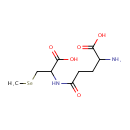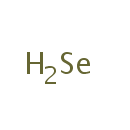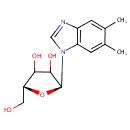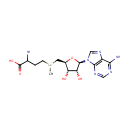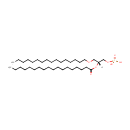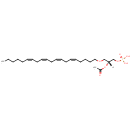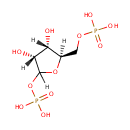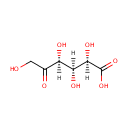
Search Results for compounds
Searching compounds for
returned 4373 results.
gamma-Glutamyl-Se-methylselenocysteine (PAMDB000803)
IUPAC:
2-amino-4-{[1-carboxy-2-(methylselanyl)ethyl]carbamoyl}butanoic acid
CAS: Not Available
Description: gamma-Glutamyl-Se-methylselenocysteine is an intermediate in selenoamino acid metabolism(KEGG ID C05695). It is generated from Se-methyl-selenocysteine via the enzyme gamma-glutamyltranspeptidase [EC:2.3.2.2].
Hydrogen selenide (PAMDB000804)
IUPAC:
hydrogen selenide
CAS: Not Available
Description: Hydrogen selenide is a metabolite of selenium which could have potential antiangiogenic effect in the chemoprevention of cancer. The hydrogen selenide is a key intermediate in the selenium methylation metabolism of inorganic and organic selenium compounds. Accumulation of the hydrogen selenide resulting from inhibition of the selenium methylation metabolism, detoxification metabolic pathway of selenium, is found in animals following repeated administration of a toxic dose of selenocystine. The excess of the hydrogen selenide produced by inhibition of the selenium methylation metabolism contributes to the hepatotoxicity caused by selenocystine. (PMID: 9414580, 11799926)
N1-(alpha-D-ribosyl)-5,6-dimethyl-benzimidazole (PAMDB000805)
IUPAC:
(2S,5R)-2-(5,6-dimethyl-1H-1,3-benzodiazol-1-yl)-5-(hydroxymethyl)oxolane-3,4-diol
CAS: Not Available
Description: N1-(alpha-D-ribosyl)-5,6-dimethyl-benzimidazole is also known as alpha-ribazole. It is converted from N1-(5-Phospho-alpha-D-ribosyl)-5,6-dimethylbenzimidazole via dephosphorylation by the enzyme alpha-ribazole phosphatase (EC 3.1.3.73). It can subsequently be used to synthesize Vitamin B12 coenzyme. (KEGG)
Se-Adenosylselenomethionine (PAMDB000808)
IUPAC:
(3-amino-3-carboxypropyl)({[(2S,3S,4R,5R)-5-(6-amino-9H-purin-9-yl)-3,4-dihydroxyoxolan-2-yl]methyl})methylselanium
CAS: Not Available
Description: Se-Adenosylselenomethionine is an intermediate in Selenoamino acid metabolism. Se-Adenosylselenomethionine is converted from Selenomethionine via the enzyme S-adenosylmethionine synthetase (EC 2.5.1.6). It is then
trans,cis-Lauro-2,6-dienoyl-CoA (PAMDB000812)
IUPAC:
(2R)-4-({[({[(2R,4R,5R)-5-(6-amino-9H-purin-9-yl)-4-hydroxy-3-(phosphonooxy)oxolan-2-yl]methoxy}(hydroxy)phosphoryl)oxy](hydroxy)phosphoryl}oxy)-N-[2-({2-[(2E,5Z)-dodeca-2,5-dienoylsulfanyl]ethyl}-C-hydroxycarbonimidoyl)ethyl]-2-hydroxy-3,3-dimethylbutanimidic acid
CAS: Not Available
Description: trans,cis-Lauro-2,6-dienoyl-CoA participates in fatty acid metabolism. trans,cis-Lauro-2,6-dienoyl-CoA is converted from cis,cis-3,6-Dodecadienoyl-CoA via dodecenoyl-CoA delta-isomerase [EC:5.3.3.8] and vice-versa.
PA(16:0e/18:0) (PAMDB000814)
IUPAC:
[(2R)-3-(hexadecyloxy)-2-(octadecanoyloxy)propoxy]phosphonic acid
CAS: Not Available
Description: 2-octadecanoyl-1-hexadecyl-sn-glycero-3-phosphate is an intermediate in ether lipid metabolism. 2-octadecanoyl-1-hexadecyl-sn-glycero-3-phosphate is converted from 1-octadecyl-glycerone-3-phosphate via 1-acylglycerol-3-phosphate O-acyltransferase. (EC: 2.3.1.51) Ether lipids are lipids in which one or more of the carbon atoms on glycerol is bonded to an alkyl chain via an ether linkage, as opposed to the usual ester linkage. Ether lipids are called plasmalogens (1-O-1'-alkenyl-2-acylglycerophospholipids) if these are glycerol-containing phospholipids with an unsaturated O-(1-alkenyl) (vinyl ether) group at the first position on the glycerol chain. Plasmalogens as well as some 1-O-alkyl lipids are ubiquitous and sometimes major parts of the cell membranes in mammals and anaerobic bacteria. In archaea, ether lipids are the major polar lipids in the cell envelope and their abundance is one of the major characteristics that separate this group of prokaryotes from the bacteria. In these cells, diphytanylglycerolipids or bipolar macrocyclic tetraethers can form covalently linked bilayers.
PA(P-16:0e/18:2(9Z,12Z)) (PAMDB000815)
IUPAC:
[(2R)-3-[(1Z)-hexadec-1-en-1-yloxy]-2-[(9Z,12Z)-octadeca-9,12-dienoyloxy]propoxy]phosphonic acid
CAS: Not Available
Description: 2-(9Z,12Z-octadecadienoyl)-1-(1Z-hexadecenyl)-sn-glycero-3-phosphate is an intermediate of ether lipid metabolism. Ether lipids are lipids in which one or more of the carbon atoms on glycerol is bonded to an alkyl chain via an ether linkage, as opposed to the usual ester linkage.2-(9Z,12Z-octadecadienoyl)-1-(1Z-hexadecenyl)-sn-glycero-3-phosphate is irreversibly produced from 2-(9Z,12Z-octadecadienoyl)-1-(1Z-hexadecenyl))-sn-glycero-3-phosphoethanolamine via the enzyme phospholipase D (EC: 3.1.4.4).Plasmalogens are glycerol ether phospholipids. They are of two types, alkyl ether (-O-CH2-) and alkenyl ether (-O-CH=CH-). Dihydroxyacetone phosphate (DHAP) serves as the glycerol precursor for the synthesis of plasmalogens. Three major classes of plasmalogens have been identified: choline, ethanolamine and serine derivatives. Ethanolamine plasmalogen is prevalent in myelin. Usually, the highest proportion of the plasmalogen form is in the ethanolamine class with rather less in choline, and commonly little or none in other phospholipids such as phosphatidylinositol.
PA(20:4(5Z,8Z,11Z,14Z)e/2:0) (PAMDB000816)
IUPAC:
[(2R)-2-(acetyloxy)-3-[(5Z,8Z,11Z,14Z)-icosa-5,8,11,14-tetraen-1-yloxy]propoxy]phosphonic acid
CAS: Not Available
Description: 2-Acetyl-1-(5Z,8Z,11Z,14Z-eicosatetraenyl)-sn-glycero-phosphate is an ether lipid. Ether lipids are lipids in which one or more of the carbon atoms on glycerol is bonded to an alkyl chain via an ether linkage, as opposed to the usual ester linkage.
Ribose 1,5-bisphosphate (PAMDB000819)
IUPAC:
{[(3R,4S,5R)-3,4-dihydroxy-5-[(phosphonooxy)methyl]oxolan-2-yl]oxy}phosphonic acid
CAS: 14689-84-0
Description: Ribose 1,5-bisphosphate (Rib-1,5-P2), a newly discovered activator of phosphofructokinase. It forms rapidly during the initiation of glycolytic flux and disappears within 20 s/ Ribose 1,5-bisphosphate is a potent regulator of the fructose 6-phosphate/fructose 1,6-bisphosphate cycle. Ribose 1,5-bisphosphate is a substrate for Ribose 1,5-bisphosphate phosphokinase (EC 2.7.4.23), an enzyme that catalyzes the chemical reaction.
5-Keto-D-gluconate (PAMDB000820)
IUPAC:
(2R,3S,4S)-2,3,4,6-tetrahydroxy-5-oxohexanoic acid
CAS: 3470-36-8
Description: 5-Keto-D-gluconate is metabolized from glucose in certain bacterial species. It is an intermediate in L-idonate degradation and ketogluconate metabolism. 5-Keto-D-gluconate 5-reductase catalyzes the reversible reduction of 5-ketogluconate to D-gluconate. This is the second reaction of the L-idonate catabolic pathway after uptake of L-idonate into the cell. The enzyme specifically reduces 5-ketogluconate using either NADH or NADPH. The enzyme is also specific for D-gluconate oxidation using NADP as the coenzyme, NAD does not serve as a coenzyme.
